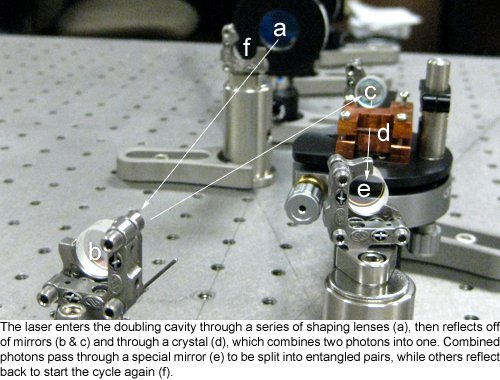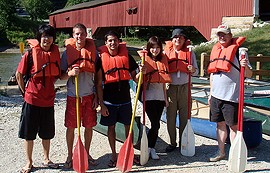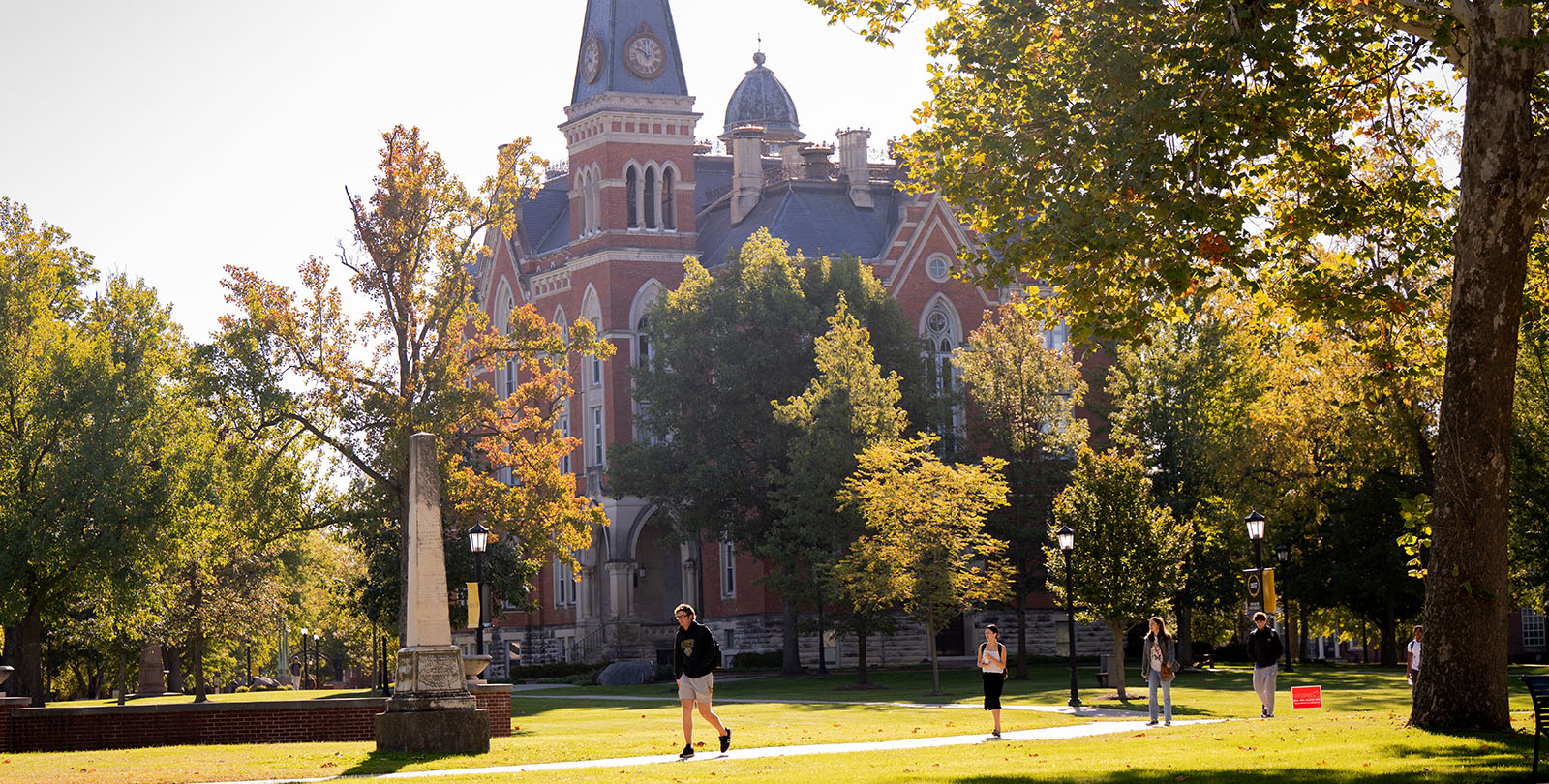Ready, Aim, Photon
August 31, 2010
As a physics professor at a small liberal arts school, it's important to find a niche -- an area of research that may have been overlooked by billion-dollar research labs. Assistant Professor of Physics and Astronomy John M. Caraher found his in virtual state spectroscopy. To appreciate how he got there, however, requires a brief lesson.
 All around us, particles of light called photons are interacting with the environment in very different ways depending on their energy, or frequency. You know this because standing in sunlight for too long can burn your skin, while the light from the computer monitor you're looking at right now is mostly harmless. Over the course of its life, a photon may at some point run across an atom, a tiny building block of matter. If the frequency of the photon is just right, some of its energy will be absorbed, "exciting" the atom and releasing a photon with a new frequency. If you've ever held a glow-in-the-dark toy up to a lamp, you're already an expert in this process.
All around us, particles of light called photons are interacting with the environment in very different ways depending on their energy, or frequency. You know this because standing in sunlight for too long can burn your skin, while the light from the computer monitor you're looking at right now is mostly harmless. Over the course of its life, a photon may at some point run across an atom, a tiny building block of matter. If the frequency of the photon is just right, some of its energy will be absorbed, "exciting" the atom and releasing a photon with a new frequency. If you've ever held a glow-in-the-dark toy up to a lamp, you're already an expert in this process.
In 1931 a physicist named Maria Goeppert-Mayer thought of a way to take advantage of photon frequency in a clever way. She hypothesized that it was possible to excite an atom using two photons of half the necessary frequency, as long as they collided with the atom at nearly the same instant. This two-photon absorption technique would allow scientists to excite atoms at a specific point in space, without worrying about the photons being absorbed along the way. Unfortunately for Goeppert-Mayer, getting two photons to collide with a single atom -- at the same time, no less -- was virtually impossible. That is, until the invention of the laser.
Laser beams are so concentrated in energy that if you focus one at a certain point, two photons are bound by chance to collide simultaneously with an atom, making Goeppert-Mayer's two-photon absorption theory possible to test. And, as you've probably gathered, it worked. Biologists have since used two-photon absorption to excite fluorescent dye molecules injected beneath thin layers of tissue, creating incredibly accurate, three-dimensional and colorful images of the inside of living organisms.
In 1998 researchers at Boston University realized that the two-photon technique could also reveal detailed information about the energy state of atoms and molecules. Typically, this would require multiple frequencies of photons for each possible energy state an atom can be in, but by using specially paired photons, the team at Boston suggested that it would possible to see all of the energy states of an atom or molecule in a single test.
That was more than a decade ago, but very little research has been done to test their theory, which they named entangled-photon virtual state spectroscopy. And that's how Caraher found his niche.
Caraher hasn't been alone in his work. Over the years, student collaborators have helped him move forward, one step at a time.
"Breaking down what needs to be done and why, in a way that's accessible to undergraduates, clarifies and extends my own thinking about the physics," he says. "One very nice thing about undergraduate physics students is that they simply want to learn. They're not worrying about publications or where they're going to land a postdoctoral position. And because everything is new to them, there's a lot of enthusiasm for even the ‘little' things."
 This summer, three DePauw students joined him in his research, and each became a specialist in different facets of the project. On a limited budget, they created most of the test equipment on their own. A mere $100,000 could have bought the equipment they needed, but where's the fun in that?
This summer, three DePauw students joined him in his research, and each became a specialist in different facets of the project. On a limited budget, they created most of the test equipment on their own. A mere $100,000 could have bought the equipment they needed, but where's the fun in that?
Ashwin A. Upasani '12 (r), a physics major from Pune, India, calibrated the team's laser. For two-photon absorption to work in an atom, the laser beam carrying the photons needs to be at a very precise frequency. But Upasani couldn't just type in a number and flip a switch. There are dozens of factors that need to be measured in order for the laser beam to remain constant, and even a change in temperature could throw things off.
Jonathan D. Cripe '12 (m), a physics and math double major from Belleville, Ill., built the project's "doubling cavity," an arrangement of mirrors and lenses around a special crystal that combines pairs of photons into single photons. The arrangement of the doubling cavity (pictured below) needs to be precise down to less than a wavelength of light, requiring special adjusters that make nearly imperceptible adjustments in cavity size.

In later experiments, these combined photons will be split by a similar crystal into pairs, each with half the original's frequency. The child photons are considered to be "entangled," cosmically connected to each other throughout their lives -- necessary for the test to work correctly, according to theory. In an entangled pair, only one of the particles needs to be tested in order to know the precise state of the other, no matter how far away they may be. Another advantage: because the entangled photons are born together, it's easier to redirect them so that they collide with an atom at the same time, meaning more efficient absorption.
Yujiao "Cindy" Qin '11, an economics and physics double major from Nanjing, China, acted as the team's analyst and programmer. She created computer models to explore the theory behind virtual state spectroscopy and ran calculations to test the accuracy of previously observed results. Using the predictive model from the researchers at Boston University, she created graphs for different atoms and larger molecules that Caraher's group can use for comparison. Ultimately, the results from this project, which continues next summer, will either follow or differ from what the theory suggests, raising entirely new questions.
This is pretty intense research for three undergraduate students, but it's also a great opportunity to learn while exploring new ground.
"Virtual state spectroscopy is a very lightly discussed area in optic physics, and there are a limited number of physicists researching it right now," Qin explains. "That's why our experiment is so important, yet so difficult. When I'm stuck somewhere, nobody is able to tell me what went wrong. I have to go back through every single detail of the theory and figure out why it is not working. But at the same time, I've enjoyed this constant problem-solving experience."
"Professor Caraher has been really good about helping us anytime we have questions or if we just need to bounce ideas off him," Cripe adds. "He has also been very flexible and understands that you can't ‘force' research."
 In order to reduce interference in their instrumentation, Caraher and his students conduct most of their work in a basement lab in the Percy Lavon Julian Science & Mathematics Center, but not all their time together was spent cloistered underground. Cripe, Upasani and Qin made a weekend trip to Chicago together, and even joined Caraher and another summer research group on a recent canoe trip.
In order to reduce interference in their instrumentation, Caraher and his students conduct most of their work in a basement lab in the Percy Lavon Julian Science & Mathematics Center, but not all their time together was spent cloistered underground. Cripe, Upasani and Qin made a weekend trip to Chicago together, and even joined Caraher and another summer research group on a recent canoe trip.
"It was a nice break, and we all had a terrific time," Upasani says. "I like that we can take time off once in a while with our professors and actually spend time outside of school with them. Of course, we were trying various applications of physics while canoeing, but that's what happens when you put a lot of physicists together."
